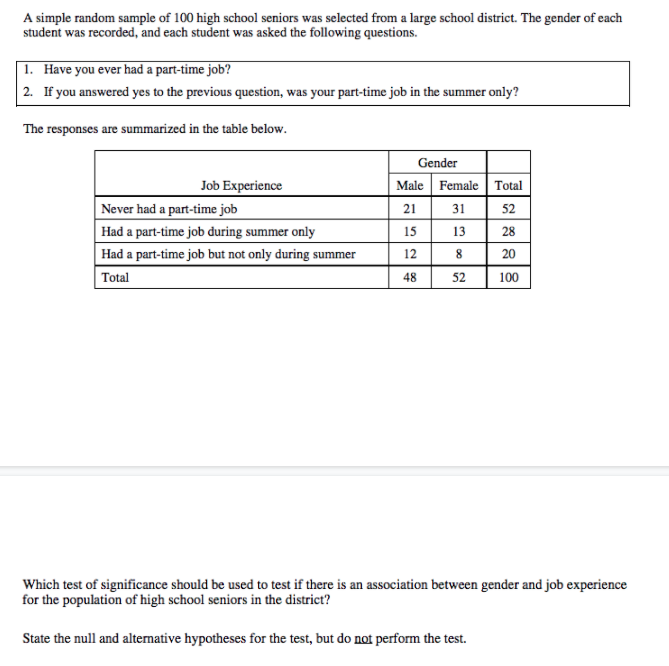8.7 Skills Focus: Selecting an Appropriate Inference Procedure for Categorical Data
2 min read•april 28, 2021
Josh Argo
AP Statistics 📊
265 resourcesSee Units
8.7: Skills Focus: Selecting an Appropriate Inference Procedure for Categorical Data
The Most Important Part of Unit 8
The most difficult and most important part of Unit 8 is being able to select which Chi-Squared test to perform. Be sure to study these important distinctions for clarity on which test to select:
- Goodness of Fit Test: One sample, one categorical variable with more than 2 categories
- Independence Test: One sample, two categorical variables with multiple categories
- Homogeneity Test: Two samples, one categorical variable with possible multiple categories
It is very likely that you will see 1 or 2 multiple-choice questions on this exact content: selecting an appropriate inference method.
Example
On the 2009 AP Statistics exam, the following question was presented in the FRQ section:

Image from released CollegeBoard material
The first thing we should notice is that this data is dealing with categorical data. This tells us that we should either use a z test or a chi squared test, depending on how many variables and categories we are dealing with.
Then we notice that there are two categorical variables with 2-3 categories apiece. This narrows out a z test since a 1 prop z test or 2 prop z test would only be valid if each variable only had two categories. Since we have two variables with multiple categories, this shifts us to a chi-squared procedure.
Now we are stuck between the three types of chi-squared tests.
The first thing to notice now is that we have a two way table, not a one way table with multiple rows/columns so that narrows it down to either chi-squared test for independence or chi-squared test for homogeneity.
The last thing we need to check in narrowing this down is how many samples/populations we have. Since we only took one sample and asked their gender and job experience, this would mean that we are looking at the association between gender and job experience, not the difference in two populations. Therefore, we should run a chi squared test for independence.
Our hypotheses then should be:
- Ho: There is no association between gender and job experience for high school seniors in the district.
- Ha: There is an association between gender and job experience for high school seniors in the district.
Things to remember: be sure to put your hypotheses in context and your null hypothesis is always the “expected” outcome AKA there is nothing special going on.
🎥 Watch: AP Stats Unit 8 - Chi Squared Tests
Browse Study Guides By Unit
👆Unit 1 – Exploring One-Variable Data
✌️Unit 2 – Exploring Two-Variable Data
🔎Unit 3 – Collecting Data
🎲Unit 4 – Probability, Random Variables, & Probability Distributions
📊Unit 5 – Sampling Distributions
⚖️Unit 6 – Proportions
😼Unit 7 – Means
✳️Unit 8 – Chi-Squares
📈Unit 9 – Slopes
✏️Frequently Asked Questions
✍️Free Response Questions (FRQs)
📆Big Reviews: Finals & Exam Prep

Fiveable
Resources
© 2023 Fiveable Inc. All rights reserved.